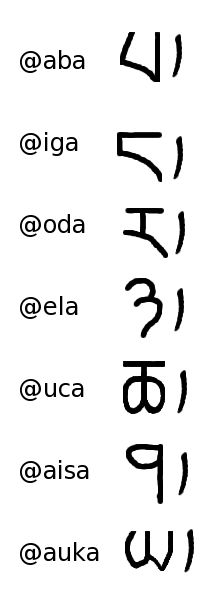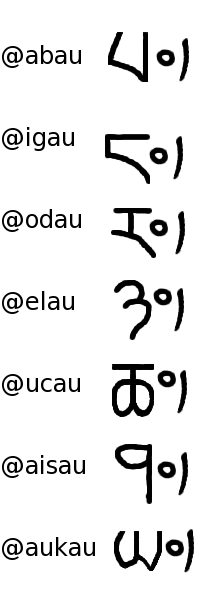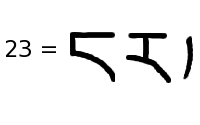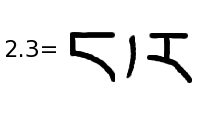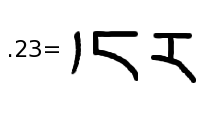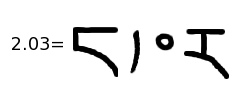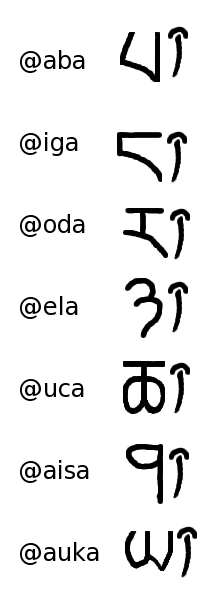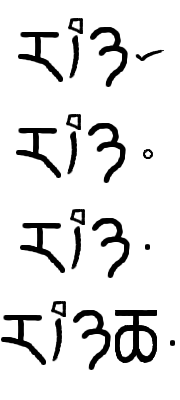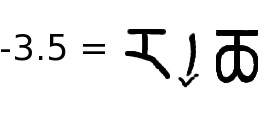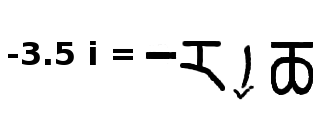Numbers in Seuna
In Seuna the number system uses base 8. Remember that all the numbers in this section are in octal, even if not specifically marked as such.
Zero
Seuna has a symbol for zero (actually similar to our "o" but a bit smaller). It is called nyegatuna (gap symbol).
From 1 to 7
| @aba | @iga | @oda | @ela | @uca | @aisa | @auka |
| one | two | three | four | five | six | seven |
Seuna doesn't have separate symbols for the numbers 0 to 7, but instead uses letter symbols. Also a vertical slash is included. Every Seuna number must have a vertical slash. Unlike words which are written next to other words with no spaces between, a number must be separated by spaces on both sides.
From 10 to 77
| 108 | @abau |
| 208 | @igau |
| 308 | @odau |
| 408 | @elau |
| 508 | @ucau |
| 608 | @aisau |
| 708 | @aukau |
Every two digit number (i.e. 10 to 77) has its own unique word which can be worked out quite easily. For example "twenty three" is pronounced as @igauda and written ;-
From 100 to 777
| 1008 | @abai |
| 2008 | @igai |
| 3008 | @odai |
| 4008 | @elai |
| 5008 | @ucai |
| 6008 | @aisai |
| 7008 | @aukai |
The numbers 100 -> 700 are written similarly as the numbers 10 => 70 but with two zero's instead of one. . It wasn't thought necessary to illustrate them.
As with two digit numbers, every three digit number (i.e. 100 to 777) has its own unique word which can be worked out quite easily, For example ;-
@abaikauda = 1738
@ucaiba = 5018
There is also another equally valid (but rarely encountered) way to write 501. It is shown below.
The above form of "501" will be explained in the next section.
From 1000 to 1036-1
So far we have been able to express every number by one word. However numbers over 777 can not be so expressed.
Numbers over 777 need at least one "rank" word as well. These words are a bit like our prefixes "kilo", "Mega", etc.
However there are some differences in usage. In Seuna it would not be allowed to say 2,000 km, but you would have to say 2 Mm (two Mega meters). It would not be allowed to say 2,175 km but you would have to say 2 M 175 k m (two Mega one hundred and seventy five kilo meters). If the number has a high "dynamic range" it will need a number of "rank" words.
The Seuns "rank" words are given below.
| 83 | m | mu |
| 86 | y | yu |
| 89 | j | ju |
| 812 | f | fu |
| 815 | p | pu |
| 818 | t | tu |
| 821 | w | wu |
| 824 | n | nu |
| 827 | h | hu |
So for example;-
The equatorial circumference of the earth would be given as @igaidau yu @aisaikauka mu @elaibaula meters * ( 230,677,414 8= 40,075,02010)
Note that the "rank" word is written as a vertical slash surmounted by a letter. Note also that we have a number word then a rank word then a number word ... and so on.
- Of course the "meter" is not a Seuna unit of measurement. Seuna has its own units for all qualities.
Numbers over 777 are called "rank numbers"
Numbers from 1000 upto 1036-1 are more specifically called "first rank numbers".
The vertical slash
The vertical slash that must come with all numbers, when unadorned with a superscript or a subscript, can function as a decimal point. Also when occurring at the left hand side of a number or in the middle of a number it is pronounced when speaking out the number. For example ;-
(feti means vertical)
From 1 to 10-36-1
Of course there is also a way of representing numbers smaller than one, as well. The table below shows the "rank" words used for this.
| 8-3 | m | mi |
| 8-6 | y | yi |
| 8-9 | j | ji |
| 8-12 | f | fi |
| 8-15 | p | pi |
| 8-18 | t | ti |
| 8-21 | w | wi |
| 8-24 | n | ni |
| 8-27 | h | hi |
It is exactly the same system as for numbers upto 1036-1. Except this time the "rank" numbers are written as small letters under the feti.
Ordinal numbers
Ordinal numbers are adjectives so come after the word that they qualify.
Ordinal numbers are the same as cardinal numbers, except that the final "a" becomes an "i".
@oda dwolo = three houses
dwolo @odi = the third house
Very very big numbers
The "rank" words are cycled round again to represent even bigger words. This range of numbers are known as the "second rank numbers". @igi of course means "second". For this second cycle of "rank" numbers, the vertical slash has a short horizontal bars about halfway up.
| 830 | mu @igi |
| 833 | yu @igi |
| 836 | ju @igi |
| 839 | fu @igi |
| 842 | pu @igi |
| 845 | tu @igi |
| 848 | wu @igi |
| 851 | nu @igi |
| 854 | hu @igi |
And there are rank numbers above this. 857 would be called mu @odi and written as the letter "m" over a vertical slash. The vertical slash having two sort horizontal bars about halfway up.
Very very small numbers
These are expanded also. In the same manner as the very big numbers.
Fractions
These are formed by the prefix sa. Probably derived from sai@u which means "part".
| a half | sa@iga |
| a third | sa@oda |
| a fourth | sa@ela |
| a fifth | sa@uca |
| a sixth | sa@aisa |
| a seventh | sa@uaka |
If it is a very big number that you want to convert, the LHS* edge of the number might be a "rank" number. sa can not be prefixed to "rank numbers" or feti. In these cases the word sa@aba is introduced as the LHS component of the number.
- LHS = Left hand side.
Nouns from numbers
klolo = wheel, klolaga = bicycle ?? kloli = vehicle ??
To show the exactness of a number
Three symbols that when placed over "letters", represent vowels, are used to give some idea of the exactness of a number.
The basic number above @oda mu @elai which we can say is "three thousand four hundred"(roughly).
The first word has the "i" vowel symbol after it. It would be pronounced @oda mu @elai tiki ... tiki simple means "exactly"
The second word has the "u" vowel symbol after it. It would be pronounced @oda mu @elai jubu ... jubu simple means "approximately". Note that this symbol is very similar to the symbol for zero. However as zero will never occur on the trailing edge of a number, there is no chance of misidentification.
The third word has the "a" vowel symbol after it. It would be pronounced @oda mu @elaia . This expression denote the range of numbers from 3,400 => 3,477.77777 ...
The fourth word would be pronounced @oda mu @elaicaua . This expression denote the range of numbers from 3,450 => 3,457.7777 ...
When @oda mu @elaicaua is followed by the locative case clitic, it mean one number in the range 3,450 => 3,457.7777 ...
Negatives numbers
A negative is represented by putting ??? , which means "down" or "downwards" after the number. It is represented by putting a sort of "v" sign under the feti.
If the feti also held a "rank number" underneath, then this "rank number" would go under the "v".
Complex numbers
A bar sign indicates a complex number. The real part is to the left of the bar and the imaginary part is to the right of the bar.
The imaginary part is pronounced by putting "side" or "sideways" before the number.
If there is no real part, then it is simply left out, and the bar is on the leftmost side of the number (imaginary number).
The above wound be pronounced as "side" "down" @oda feti @ucai.
Mathematical operations
Addition
| Western mathematical notation | Which is pronounced | |
| 2 + 3 = 5 | two and three is five | |
| Seuna mathematical notation | Which is pronounced | |
| 2,3>5 | aga ada ro aca |
Subtraction
For subtraction, or addition which inviolves negative numbers, each number must be followed by either "forward" or "backward" depending upon whether the number is possitive or negative.
Multiplication
There is a particle je which is placed between words to be multiplied.
| Western mathematical notation | Which is pronounced | |
| 2 x 3 = 5 | two times three is five | |
| Seuna mathematical notation | Which is pronounced | |
| 2+3>5 | aga je ada ro aca |
Division
15 divided by 5 is 3 ............. 15 shared 3ji is 5
tonda means "to add" or "addition", and jemba means "to multiply" or "multiplication". ??? tondua = subtraction, jembua = division ???
Index
- Introduction to Seuna
- Seuna : Chapter 1
- Seuna word shape
- The script of Seuna
- Seuna sentence structure
- Seuna pronouns
- Seuna nouns
- Seuna verbs (1)
- Seuna adjectives
- Seuna demonstratives
- Seuna verbs (2)
- Asking a question in Seuna
- Seuna relative clauses
- Seuna verbs (3)
- Methods for deriving words in Seuna
- List of all Seuna derivational affixes
- Numbers in Seuna
- Naming people in Seuna
- The Seuna calendar
- Seuna units
